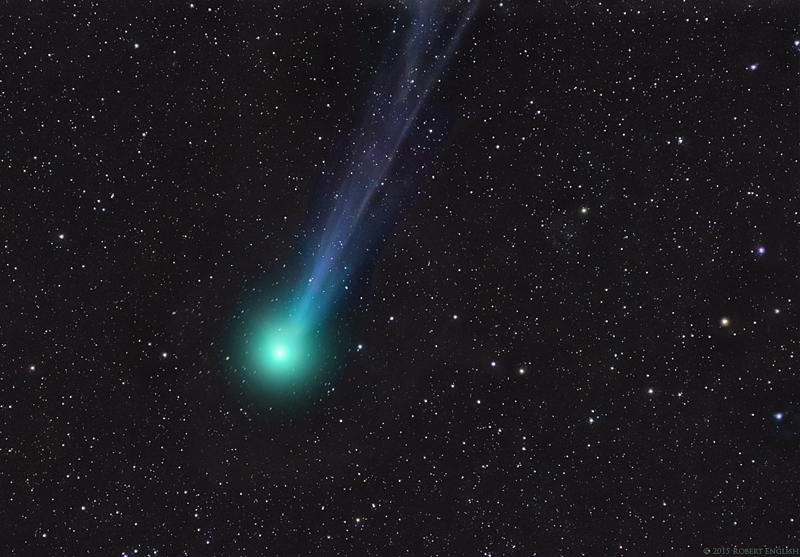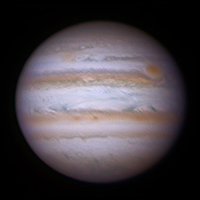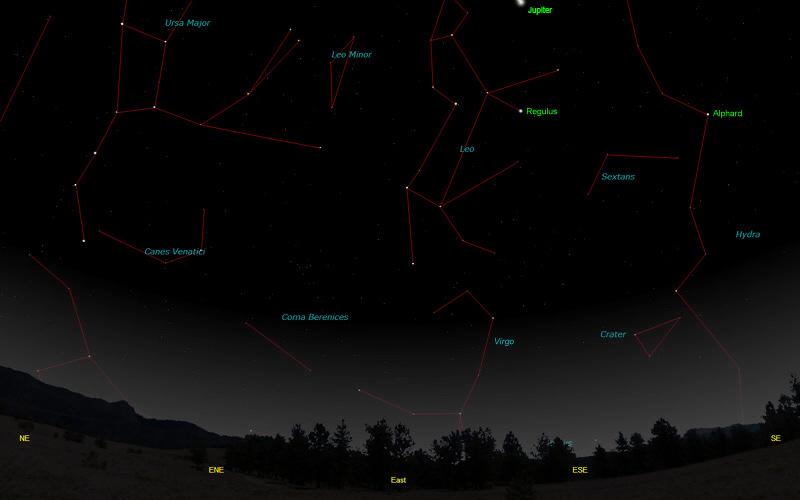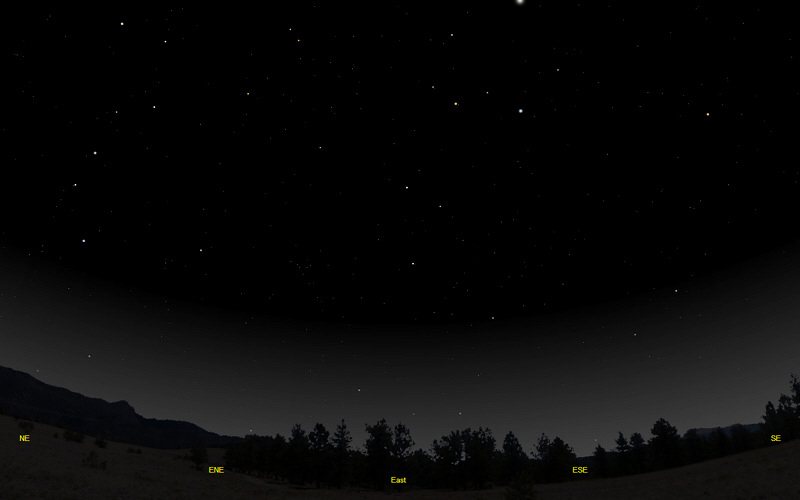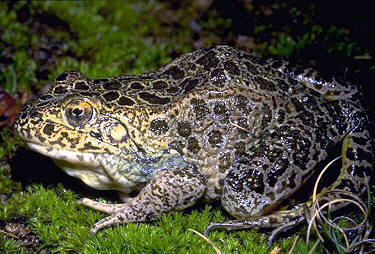The purpose of this feature is to give scout leaders, educators and naturalists an idea of some of the natural events coming up each month. We will try to cover a variety of natural events ranging from sky events to calling periods of amphibians, bird and mammal watching tips, prominent wildflowers and anything else that comes to mind. We will also note prominent constellations appearing over the eastern horizon at mid-evening each month for our area for those who would like to learn the constellations. If you have suggestions for other types of natural information you would like to see added to this calendar, let us know! Note: You can click on the hyperlinks to learn more about some of the featured items. To return to the Calendar, hit the "back" button on your browser, NOT the "back" button on the web page. All charts are available in a "printer friendly" mode, with black stars on a white background. Left clicking on each chart will take you to a printable black and white image. Please note that images on these pages are meant to be displayed at 100%. If your browser zooms into a higher magnification than that, the images may lose quality. Though we link book references to nationwide sources, we encourage you to support your local book store whenever possible. Notes and Images From January 2014 In January we watched Comet Lovejoy grow brighter each day. It soon became easily visible to the naked eye as a faint misty spot. My first two photographic attempts were among the coldest nights I've spent sky watching. On January 7th the sky cleared as a severe cold front passed through. That night it was 13 degrees Fahrenheit while I was taking images, with a gusting 20 mph wind that brought the wind chill down to around zero. I also tried on January 9th, which was almost as cold. Despite the frigid conditions, both nights were beautiful. As I set up my scope at dusk I watched Mercury and Venus do their dance in the western sky. After I finished I watched Jupiter rise near the sickle of Leo, accompanied by a waxing Moon.
Then, on January 16th, a rarity, a crystal clear winter night with mild temperatures. The comet was at peak brightness, drifting slowly through the stars of Aries. I hand guided each 120-second sub-exposure with a home-made guiding eyepiece. Though not visible to the eye, a long blue ion tail extended away from the comet, only part of which is shown in the image above. The greenish glow around the head of the comet is caused by diatomic carbon fluorescing. The tail glows with the light of fluorescing carbon monoxide ions. The comet is now fading. This was the best comet visible for northern hemisphere sky watchers in a long time, and we savored every moment. We were out in our field on January 19th when we got another pleasant surprise. We heard the unmistakable sound of Sandhill Cranes overhead. Looking skyward, we saw them - 19 Sandhill Cranes in two V's, heading northward. The call of Sandhill Cranes is one of our favorite natural sounds, a call that seems to say that not all of nature has been lost to the suburbs. Seeing the light gray birds, necks outstretched, against the dark blue sky was a beautiful sight.
Sky Events for February 2015: Evening Sky: Mars continues to be visible in the western sky at dusk, and can be found close to Venus much of the month. Mars will start out the month above Venus, pass it on February 21st, and finish the month below Venus. The two planets are closest on the 21st, when they are less than one half a degree apart. Look for them about 30 minutes after sunset. Binoculars will be a big help in spotting Mars. Telescopically, Mars is tiny, less than 5 seconds of an arc in apparent diameter. Venus continues to climb into the western sky after sunset in February. Look for it about 30 minutes after sunset. You can use it as a guide to find fainter Mars (see above).
Jupiter rises at dusk at the beginning of the month in Leo. Wait for it to climb high in the sky to get the best telescopic view. Morning Sky: Saturn rises about 2:00am at the beginning of the month in Scorpius. Look for it low in the southeast. Saturn's rings have opened up to a nearly 24 degree tilt, giving a wonderful view of the ring system through just about any aperture telescope. Wait till just before dawn to get the best view. Mercury reaches greatest elongation from the Sun on February 26th. It will be very low in the dawn twilight however. All times noted in the Sky Events are for Franklin, Tennessee and are Central Standard Time. These times should be pretty close anywhere in the mid-state area. Constellations: The views below show the sky looking east at 9:30pm CST on February 15th. The first view shows the sky with the constellations outlined and names depicted. Star and planet names are in green. Constellation names are in blue. The second view shows the same scene without labels. Leo, the Lion, is prominent with its bright star Regulus. Look above Regulus for bright Jupiter. Use Regulus and Leo to guide you to the faint constellation of Sextans, the Sextant. Conspicuous in the northeast is Ursa Major, the Great Bear. Near the "snout" of the bear lie two great galaxies, Messier 81 and Messier 82. These can be seen as faint smudges in binoculars on a clear night, and observers in pristine skies have even reported seeing a glimpse of M81 with the naked eye. The constellations of Coma Berenices, Berenice's Hair, Virgo, the Virgin and Crater, the Cup are all just making their way above the horizon and will be seen better next month. If you can't wait, you can always stay up a little later and watch them as they climb higher above the horizon.
On Learning the Constellations: We advise learning a few constellations each month, and then following them through the seasons. Once you associate a particular constellation coming over the eastern horizon at a certain time of year, you may start thinking about it like an old friend, looking forward to its arrival each season. The stars in the evening scene above, for instance, will always be in the same place relative to the horizon at the same time and date each February. Of course, the planets do move slowly through the constellations, but with practice you will learn to identify them from their appearance. In particular, learn the brightest stars (like Regulus in the above scene looking east), for they will guide you to the fainter stars. Once you can locate the more prominent constellations, you can "branch out" to other constellations around them. It may take you a little while to get a sense of scale, to translate what you see on the computer screen or what you see on the page of a book to what you see in the sky. Look for patterns, like the stars of the "Big Dipper." The earth's rotation causes the constellations to appear to move across the sky just as the sun and the moon appear to do. If you go outside earlier than the time shown on the charts, the constellations will be lower to the eastern horizon. If you observe later, they will have climbed higher. As each season progresses, the earth's motion around the sun causes the constellations to appear a little farther towards the west each night for any given time of night. If you want to see where the constellations in the above figures will be on March 15th at 9:30pm CST, you can stay up till 11:30pm CST on the February 15th and get a preview. The westward motion of the constellations is equivalent to two hours per month. For instance, if you want to see what stars will be on your eastern horizon on May 15th at 9:30pm CST (3 months from now), you would need to get up at 3:30am CST on February 15th (3 months times 2 hours/month = 6 hours). Recommended: Sky & Telescope's Pocket Star Atlas is beautiful, compact star atlas. A good book to learn the constellations is Patterns in the Sky, by Hewitt-White. You may also want to check out at H. A. Rey's classic, The Stars, A New Way to See Them. For skywatching tips, an inexpensive good guide is Secrets of Stargazing, by Becky Ramotowski. A good general reference book on astronomy is the Peterson
Field Guide,
A Field Guide to the Stars and Planets, by Pasachoff. The book retails for around $14.00. Starry Night has several software programs for learning the night sky. Visit the Starry Night web site at www.starrynight.com for details. The Virtual Moon Atlas is a terrific way to learn the surface features of the Moon. And it's free software. You can download the Virtual Moon Atlas here. Cartes du Ciel is a great program for finding your way around the sky. It is also free, and can be downloaded here. Apps: We really love the Sky Safari Pro application described here. For upcoming events, the Sky Week application is quite nice. Both apps are available for both I-phone and Android operating systems. The newest version, Sky Safari 4, is available from Play Store or from i-tunes.
Amphibians:
The amphibian season continues to build in February. One trick to finding amphibians in winter is to go out on mild (50 degrees Fahrenheit or warmer) rainy nights. If you do find a mild night, it is important for safety reasons that you have another person with you to help watch for traffic as you slowly drive the back roads. Look for things that cross the road in front of you and stop frequently and listen. Early breeding frogs like Upland Chorus Frogs, Spring Peepers and Wood Frogs are already calling by the first of the month. On warmer nights listen for Southern Leopard Frogs. Spotted Salamanders and Tiger Salamanders also breed in January and February, and the eggs of both can often be found this time of year. Towards the end of the month, given mild temperatures, you can sometimes hear American Toads beginning to call. In west Tennessee, Crawfish Frogs give their loud snoring calls starting in late February and continuing on into early March. At higher elevations, listen for Mountain Chorus Frogs towards the end of the month. Remember that on mild nights you may find frogs and toads out foraging that you do not hear until later in the season.
Birds: Many times when we have been out looking for amphibians in February we've witnessed courtship flights of the American Woodcock. Listen for the "peent" call at dusk and watch as the male Woodcock spirals upward till it's almost out of sight, then dives back to the ground, twisting and turning. For more about watching American Woodcocks see, "The Woodcock's Call." Red-Shouldered Hawks mate as early as February in Tennessee. Watch for courtship activities of these and other hawks. Stick Nests: With the leaves down, this is a great time of year to find raptor stick nests. I make notes of all the nests I find and then periodically check them to see if anyone has "moved in." Many times Great Horned Owls make use of an old Red-Tailed Hawk's nest from the previous year. The owls can already be incubating eggs in January. Of the hawks, Arthur Cleveland Bent, in his "Life Histories of North American Birds of Prey," writes, "[Red-tailed Hawks]...begin their nest building late in February or early in March; I have seen a wholly new nest half completed and decorated with green pine twigs and down as early as February 18th, over a month before the eggs are laid...Typical nests are from 28 to 30 inches in outside diameter, the inner cavity being 14 or 15 inches wide and 4 or 5 inches deep...The nests are well made of sticks and twigs, half an inch or less in thickness, and neatly lined with strips of inner bark, of cedar, grapevine or chestnut, usnea, and usually at least a few green sprigs of pine, cedar or hemlock. Some nests are profusely and beautifully lined with fresh green sprigs of white pine, which are frequently renewed during incubation and during the earlier stages of growth of the young...They "stake out their claim" late in February or early in March...by marking the nest they propose to use with a sprig of green pine...I believe that the birds prefer to build a new nest each year, but they sometimes use the same nest for consecutive years..." Bent was writing about the Red-Tail Hawks in New England, so our times could be a little earlier. You probably have already put out your bird feeders, but if you havenít you're missing out on a lot of good looks at winter feeder birds. This is a great time of year to start learning your birds. Watch and listen for winter residents such as White-throated and White-crowned Sparrows, Yellow-bellied Sapsuckers, Red-breasted Nuthatches, Golden-crowned Kinglets and Brown Creepers. Recommended: The Sibley Guide to Birds, David Allen Sibley The Sibley Guide to Birds of Eastern North America, David Allen Sibley An inexpensive guide for beginners is the Golden Guide for Birds. Archives (Remember to use the back button on your browser, NOT the back button on the web page!) Natural Calendar December 2014 Natural Calendar November 2014 Natural Calendar September 2014 Natural Calendar February 2014 Natural Calendar December 2013 Natural Calendar November 2013 Natural Calendar September 2013 Natural Calendar December 2012 Natural Calendar November 2012 Natural Calendar September 2012 Natural Calendar February 2012 Natural Calendar December 2011 Natural Calendar November 2011 Natural Calendar September 2011 Natural Calendar February 2011 Natural Calendar December 2010 Natural Calendar November 2010 Natural Calendar September 2010 Natural Calendar February 2010 Natural Calendar December 2009 Natural Calendar November 2009 Natural Calendar September 2009 Natural Calendar February 2009 Natural Calendar December 2008 Natural Calendar November 2008 Natural Calendar September 2008 Natural Calendar February 2008 Natural Calendar December 2007 Natural Calendar November 2007 Natural Calendar September 2007 Natural Calendar February 2007 Natural Calendar December 2006 Natural Calendar November 2006 Natural Calendar September 2006 Natural Calendar February 2006
Natural Calendar December 2005
Natural Calendar November 2005
Natural Calendar September 2005
Natural Calendar February 2005
Natural Calendar December 2004
Natural Calendar November 2004
Natural Calendar September 2004
Natural Calendar February 2004
Natural Calendar December 2003
Natural Calendar November 2003
Natural Calendar September 2003 Natural Calendar February 2003 Natural Calendar December 2002 Natural Calendar November 2002 Nature Notes Archives: Nature Notes was a page we published in 2001 and 2002 containing our observations about everything from the northern lights display of November 2001 to frog and salamander egg masses. Night scenes prepared with The Sky Professional from Software Bisque All images and recordings © 2015 Leaps
|
